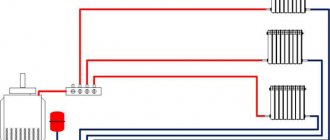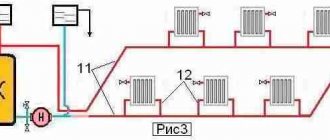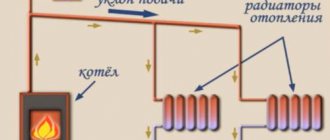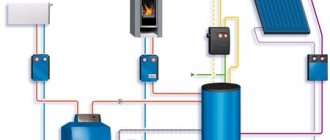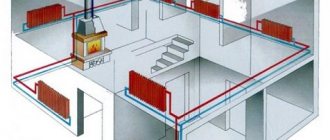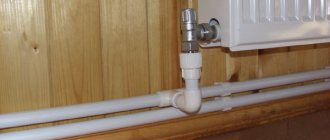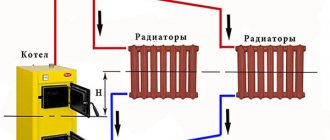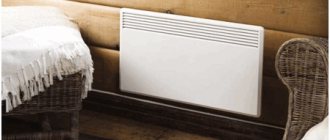Category: construction Posted on 10/24/2019 Comments: Read: 3 min Views: Post Views: 4 272
Heating a house is a "vital" process, and therefore it is not surprising that there are many different ways, devices and technologies in order to practically and efficiently heat a home. Systems may differ in their technology and structure, but the main thing is that they provide efficient heating of the room.

Heating with a radiator is natural for the present. The system itself is subdivided into gravitational, in which circulation depends on the heat carrier, and forced, in which additional elements (pump) are needed for circulation.
Some heating systems are gradually becoming obsolete and replaced by new ones. However, there are those who are returning to everyday life due to their practicality or economy. The Spider heating system is one of these. This system has been forgotten because modern heating systems are closed, and circulation pumps are widely used in them. However, for heating small private houses, it is still an excellent heating option.
The "Spider" consists of a direct heat source (which can operate on any fuel), an expanded tank (it is fixed at the top), pipelines and the actual radiators. Due to its appearance (schematic) and location, the system got its name.
An expanded tank (reservoir) is installed in the attic of the building, which must be well insulated. Risers are suitable for it, which lead to a heat source and radiators. When the coolant cools down, it leaves cold through horizontally located pipes (mains).
Electric boilers for heating a private house - their main advantages and disadvantages
That is why an electric boiler is increasingly used in modern homes, the mention of which many associate with the very high cost of operating it.
It is quite reasonable that electric power is quite expensive today, but if there is no desire to fiddle with wood, coal or diesel fuel, and there is no natural gas, there is simply no other choice.
An electric boiler has the following advantages:
- it is easy to install, the requirements that accompany its installation are easy to fulfill, and there are not many of them, and most importantly, licensing of work is not required;
- low installation cost, and when used in rooms with short-term operation, heating can become even cheaper than gas;
- it is easier to operate, and maintenance does not require special knowledge, in addition, it is the most automated, which allows you to simply set the required heating mode;
- ensuring safety, during its operation, carbon monoxide hazardous to human health does not form, and the possibility of an explosive gas-air mixture is excluded.
Heating a house with an area of 150 square meters requires about 15 KW / h, it is difficult to get this power outside the city, where 5 KW / h is already a great achievement.
And laying a three-phase line in terms of cost and the number of required permits is comparable to laying a gas pipe to a house.
This is the main disadvantage of electric boilers.
In economic terms, the choice of an electric heater as a heat source is very successful.
Direct electric heating is the most popular type of heating in Europe and the most promising in our country.
Direct electric heating of a private house
Electric heating systems for private houses are extremely popular today.
They operate on the most expensive of all energy carriers available in our country - electrical energy.
Direct electric heating systems are used, both to fully cover the required heating and for peak loads and maintain a constant room temperature.
When choosing an electric heating option, it is very important to take into account what building materials the house is made of.
From the ability of the walls of the house to store heat directly, the choice of a heating device will be determined.
If we compare housing heating directly with electricity with other available methods, then many facts speak in its favor.
For example, this method of heating rooms requires only the presence of special heaters in them.
No other equipment is required for this at all.
There is no need to worry about the coolant or the installation of a special kind of ventilation system.
Such heaters independently transform electric current into thermal energy.
They do not need various "intermediaries" from boilers, heat carriers and other equipment.
Heating a house with electricity has many significant advantages, among which the following should be highlighted:
- ease, convenience and reliability of system operation;
- possibility of regulation and efficient heat transfer;
- noiselessness of the heating system;
- small dimensions of heating devices that do not require labor-intensive and high-cost special care;
- high environmental safety and hygiene of electric heaters.
Heating schemes


Water heating system
Water heating is the most common option for heating any type of room. In most cases, the role of the coolant here is played by water, which is supplied from the boiler to the heating radiators..
In general, experts distinguish between two types of water systems:
- With natural circulation of water (when pressure is formed in the circuit itself);
- With forced circulation (water enters the pipes and radiators using a circulation pump).
Any schematic diagram must include:
- Heating boiler (any type);
- Main riser;
- Reverse riser;
- Pipeline;
- Return pipeline;
- Radiators.
So, today the following heating circuit diagrams are known:
- With bottom and top routing method;
- With horizontal wiring;
- One-pipe;
- Two-pipe.
Top routing
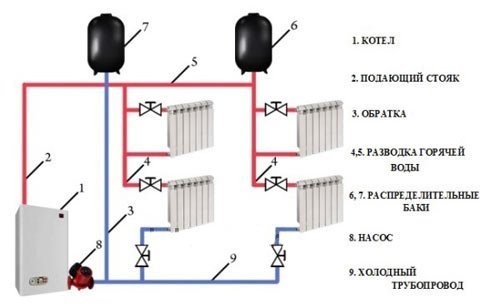

Top layout option
In this scheme, the coolant is heated in the boiler and, due to its density, rises up the riser into the heating expansion tank.
Attention! This scheme provides for the location of the expansion tank at the highest point of the heating system.
Further, through the pipeline (which, by the way, should run at a slight slope), the coolant enters the hot risers. These risers run from the top floor of the house to the first and run along the entire height of the building. The spent coolant, in turn, is simply displaced by hot water and returns to the heating boiler through pipes through the "return". To adjust the level of hot water supply at the outlet to the radiators, special shut-off valves are installed.
Bottom wiring
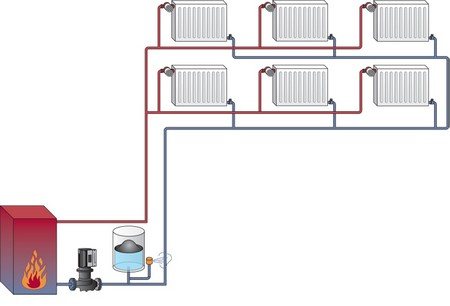

Water heating system with lower wiring option
A system with a bottom wiring has a main (supply) pipeline that provides a coolant to all other risers below the level of the residential premises. As for the return risers, they are connected to a common "return" drawn even lower.
Note! This scheme contains in its structure an overhead line located on top.With its help, all accumulated air in the radiators is automatically removed, which in turn is removed through the expansion tank.
Two-pipe systems
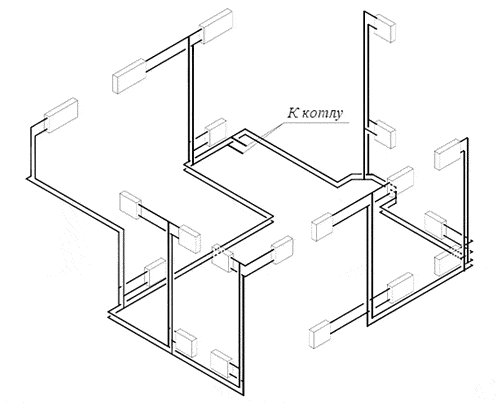

Two-pipe system with bottom routing option
In any two-pipe scheme, both with upper and lower wiring, the heated water rises up and through the pipeline enters the radiators, where it cools over time and becomes heavier. The cooled coolant flows down the return risers into the return pipe and returns to the boiler. Cold water has a higher density and mass than hot water and thus itself displaces it into the pipeline, creating natural circulation even without a pump.
One-pipe systems
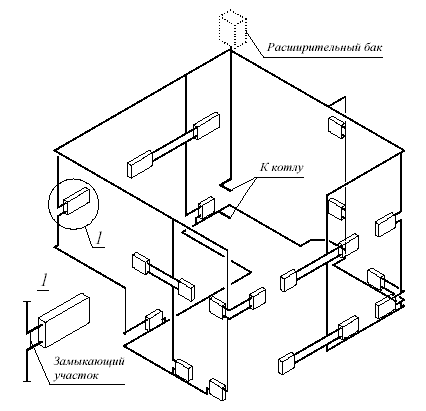

One-pipe system with top routing
At its core, this is the simplest scheme (see photo), which even an inexperienced person can make and assemble with his own hands. It differs from the two-pipe one in that, having given up its heat on the upper floor, less is transferred to the lower one. It turns out that the coolant, overcoming floor by floor, gradually cools and it turns out that the inhabitants of the first floor receive the least heat. In order to keep the residents of the lower floors from freezing, the engineers added additional sections to the heating radiators for the residents of the lower floors.
Also, the problem can be partially solved by installing special jumpers on each radiator. With bridges, part of the hot water flows to the floor below without cooling.
It should also be noted that the main riser in a one-pipe system must be protected as reliably as possible from heat loss. Otherwise, the system will lose not only heat, but also the power of the water pressure, which will negatively affect the heating of the house as a whole.
As for the return line, it is the other way around - it cannot be isolated in any case! This is due to the fact that colder water has a greater weight and, accordingly, displacing hot water, creates a stronger pressure.
One-pipe schemes with horizontal flow system


One-pipe system with horizontal flow system
This scheme is attractive in that all radiators on the floor are connected in one line. The main advantage of such a system is ease of installation. Also, you will need significantly fewer pipes and risers.
If we talk about shortcomings, then the main one is the tendency of such a system to create air jams. This problem can be solved only by installing automatic air release valves (Mayevsky valves).
Note! For those who do not know, the schematic diagrams do not contain any measuring characteristics, but only show what is connected to what and shows an approximate "harness" of the house.
Types of heaters for direct electric home heating
Since heaters are the key elements for any direct electric heating system, it is necessary at least a little to navigate the devices on our market.
This equipment is classified according to several criteria, the main one being the method of heat transfer.
For example, radiant and convective heaters.
Radiant heaters include infrared panels and mirrors that emit heat.
And the devices whose operation is based on convection are electric convectors, air heaters and heat fans.
To the above, the following types of heaters should be added - combined, convective-radiation, as well as electric heaters, whose operation is based on "indirect heating".
Principle of installation of an air heating system
A heat generator in such a system can be either a standard electric heater or a heating boiler that runs on both gas and solid fuel.
In the event that a solid fuel boiler will act as a heat generator, it is very important that it be equipped with a function to regulate the speed at which the heat source will burn. If a gas boiler is used, then it must be equipped with an automatic on and off system, as well as a function to control the temperature of the fuel, so that this indicator does not go beyond the indicated parameter.
It is required to purchase all the necessary installation materials, such as an air valve for heating, dampers, air ducts and other elements in advance and ready for installation.
Particular attention should be paid to the equipment of the air conditioner. This event must be accompanied by thermal insulation of the air ducts so that condensate, which is extremely undesirable in such a system, does not appear on them.
The main material for the manufacture of the air ducts themselves is galvanized steel, and in this case, any self-adhesive material you like can act as a heater. The structural features of a particular design will largely influence which ducts to use - rigid or flexible type. The fixation of these elements to each other is carried out by means of clamps or special reinforced tape.
Fan heaters
Another effective device for heating a room are fan heaters, which not only maintain a given temperature, but are also able to raise it in a minimum time.
In addition, they can create a thermal air curtain.
Their undoubted advantage is minimal heat loss and high efficiency.
Today on sale you can see a huge number of fan heaters of various power and quality.
Sometimes they are equipped with air filtration equipment.
Electric "warm floor"
The source of heat in such a field is a special cable built into it.
As a result, the floor turns into a large heating panel that distributes heat evenly throughout the room.
"Warm floor" allows you to create and maintain the optimum air temperature.
In addition, such a home heating system does not require additional equipment in the form of radiators, which greatly facilitates the arrangement of furniture and can be used with any floor covering.
How to correctly calculate the air heating system
The correct calculation of the heating system of air heating should be carried out taking into account the following parameters:
- air heater power indicators. This parameter should be such that the room is heated in a normal way, even taking into account all heat losses;
- the speed with which the heated air is transferred;
- the amount of heat loss carried out through window and door openings, as well as through walls and ceilings;
- the diameter that the air ducts have. Here it is important to perform a calculation of the aerodynamic characteristics in order to determine how much warm air is lost.

